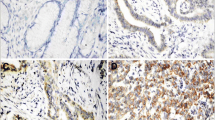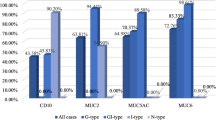Abstract
Background
Recent studies have suggested that nonsteroidal anti-inflammatory drugs (NSAIDs) reduce the risk of gastrointestinal cancer, and that cyclooxygenase-2 (COX-2) may be a target enzyme for the prevention or regression of cancer by the use of NSAIDs. Mucin histochemistry has made possible a clear distinction between the differentiated characteristics of gastrointestinal epithelial cells, and the possibility that phenotypic shifts from gastric- to intestinal-type in gastric carcinoma progression has been suggested. To evaluate the role of COX-2 in gastric cancer progression, we immunohistochemically investigated COX-2 expression, and examined its relationship to proliferative activity, mucin phenotype, and clinicopathological parameters in human advanced gastric carcinomas.
Methods
Forty-five surgical specimens of advanced gastric carcinomas (invaded the muscularis propria or subserosa) were examined. Immunohistochemical staining was performed with monoclonal antibodies against COX-2, Ki-67, CD10 (brush border), MUC-2 (goblet-cell mucin), MUC-5AC (gastric foveolar mucin), and MUC-6 (pyloric mucin). COX-2 expression was scored by the percentage of COX-2-positive neoplastic cells, and proliferative activity was assessed by the Ki-67 labeling index at the deepest area of invasion. The mucin phenotype of the carcinomas was classified into three categories; gastric, intestinal, and unclassified.
Results
COX-2 staining was restricted to the cytoplasm, not only in cancer cells but also in intestinal metaplasia and some inflammatory cells and COX-2 expression in cancer cells varied greatly, but the staining in some samples was preferentially found at the invasive front. COX-2 positivity was found to correlate with Ki-67 labeling. The mean COX-2 scores were 2.29%, 2.71%, and 2.75%; and the Ki-67 labeling indices were 23.6%, 40.6%, and 56.5%, in gastric-, intestinal-, and unclassified- type carcinomas, respectively.
Conclusions
A close relationship between COX-2 expression and proliferative activity was confirmed in the deepest areas of advanced gastric carcinoma, and the proliferative activity increased from gastric- to intestinal- and to unclassified- type gastric carcinoma, suggesting a role for COX-2 expression and differences in biological behavior according to mucin phenotype expression during gastric cancer progression.
Similar content being viewed by others
Author information
Authors and Affiliations
Rights and permissions
About this article
Cite this article
Yamagishi, M., Noda, M., Tatsumi, Y. et al. Correlation between cyclooxygenase-2, proliferative activity, and mucin phenotype in human advanced gastric cancer. J Gastroenterol 39, 1143–1149 (2004). https://doi.org/10.1007/s00535-004-1463-1
Received:
Accepted:
Issue Date:
DOI: https://doi.org/10.1007/s00535-004-1463-1




